Pannonhalmi Apátsági Pincészet Kft.
by
Kathy Sullivan
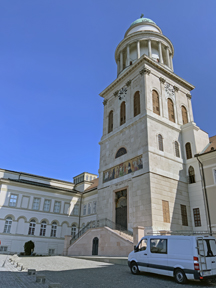 Summary: The Apátsági Pincészet located at Pannonhalmi Abbey offers an intriguing history for visitors. When visiting the winery, plan to visit the Abbey and consider a stop at the modern gourmet Viator Restaurant.
Summary: The Apátsági Pincészet located at Pannonhalmi Abbey offers an intriguing history for visitors. When visiting the winery, plan to visit the Abbey and consider a stop at the modern gourmet Viator Restaurant.
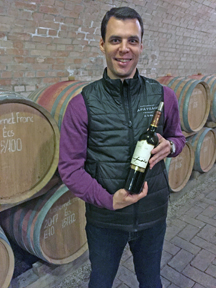 According to Tamás Illés, who conducted our tour and tasting at the winery, the main idea of the Apátsági Pincészet is the focus on the 1,000 year old history of winemaking and wine tradition. "This is a heritage we want to share with people."
According to Tamás Illés, who conducted our tour and tasting at the winery, the main idea of the Apátsági Pincészet is the focus on the 1,000 year old history of winemaking and wine tradition. "This is a heritage we want to share with people."
The Apátsági Winery at Pannonhalmi Abbey was re-established after the state controlled vineyards no longer existed. Apátsági means the Abbey. In the Pannonhalmi region, religious monks were growing grapes and producing wine as early as 996 AD. By the 1800s the region had 20 large vineyards in the area. After World War II the vineyards were decimated. More recently the Pannonhalmi Abbey decided to bring back the wine culture by establishing a winery and buying back the former vineyards. The Abbey was assisted by Tibor Gál winemaker from Eger who founded the Gál Tibor Winery.
Vineyards
Today the Apátsági Pincészet vineyards consist of 50 hectares (123.5 acres) that have a concentration of limestone, red clay and sandstone. Only a few of the vineyards can be seen from the Abbey and winery. The vineyards grape varieties include Riesling, Sauvignon Blanc, Gwürztraminer, Olaszrizling, Chardonnay, Pinot Blanc, Viognier, Pinot Noir, Merlot and Cabernet Franc.
Tamás noted that “We need to find once again our roots and tradition.”
History
Historical documents regarding the foundation of the Benedictine winemaking have been discovered. King Stephen references the making of wine as early as the year 996 AD. It was also noted that during the Roman occupation winemaking was taking place.
The Abbey was established by the Benedictine order. St. Benedict believed that monks should not drink wine but St. Benedict would not say “don’t drink wine.”The Abbey has always had a historical wine cellar dating back to the 13th century. At one time the Hungarian region was known as one of the top three wine producing countries in Europe. There was a strong connection to monastic winemakers throughout Europe. Before World War I and World War II the Abbey had more than 100 hectares (247 acres). “After World War II everything was confiscated by the state.”
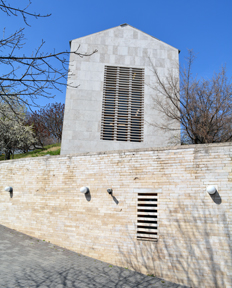 Apátsági Pincészet Today
Apátsági Pincészet Today
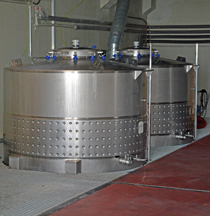 Today the modern-style winery consists of a four-story press house, both above and below the ground level. Stainless steel tanks reach up to two floors. A gravity flow system is used during the winemaking process. On some of the walls large vintage photos of winemaking and harvesting explore the history of winemaking at the Abbey. Current wine production focuses two-thirds of the production on fruit forward wines. The other one-third of production is oaked. The Pannonhalmi winery produces 380,000 bottles. Tamás noted that people like the Olaszrizling best.
Today the modern-style winery consists of a four-story press house, both above and below the ground level. Stainless steel tanks reach up to two floors. A gravity flow system is used during the winemaking process. On some of the walls large vintage photos of winemaking and harvesting explore the history of winemaking at the Abbey. Current wine production focuses two-thirds of the production on fruit forward wines. The other one-third of production is oaked. The Pannonhalmi winery produces 380,000 bottles. Tamás noted that people like the Olaszrizling best.
A modern day patio adjacent to the winery allows guests to enjoy wine tasting and the environment.
The lowest floor of the winery is the cellar and an area for wine tasting. Red bricks lined the walls and the arched ceilings. A different type of brick was used for the flooring. Barrels were stacked two high along the walls. The barrels rested on small rocks covering earth to help increase the humidity.
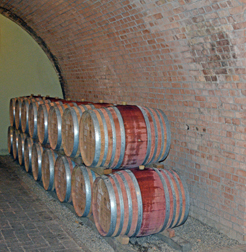
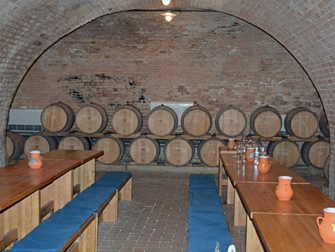
Wines
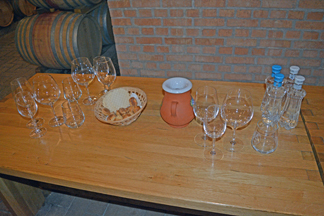 Our wine tastings at Apátsági Pincészet took place in the brick-lined arched cellar, adding ambiance to the wine tasting experience. The traditional Hungarian Pogacsa, cheese biscuits, were included in the wine tasting.
Our wine tastings at Apátsági Pincészet took place in the brick-lined arched cellar, adding ambiance to the wine tasting experience. The traditional Hungarian Pogacsa, cheese biscuits, were included in the wine tasting.
Tricollis Rosé 2018 was a blend of Pinot Noir, Merlot and Cabernet Franc. The 12.5% alcohol wine had a light red color with an orange hue. The aroma was of red berries. The silky mouthfeel offered notes of red raspberries. The finish was crisp and fruity with some minerality on the aftertaste. It was recommended that this wine should be served well chilled.
Tricollis White 2018 had 13% alcohol. This wine was a blend of Olaszrizling, Riesling and Gewürztraminer. The light yellow colored wine had an aroma of flowers. The silky mouthfeel offered a taste of daisies, roses and peaches. The finish was floral and fruity.
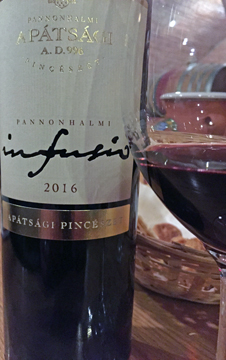 The Rajnai Rizling (Reisling) 2017 had 13% alcohol. The light yellow colored wine offered an aroma of flowers and yellow stone fruit. The taste was of roses, honeysuckle and peaches. The mouthfeel was silky. The finish was crisp.
The Rajnai Rizling (Reisling) 2017 had 13% alcohol. The light yellow colored wine offered an aroma of flowers and yellow stone fruit. The taste was of roses, honeysuckle and peaches. The mouthfeel was silky. The finish was crisp.
Hemina 2017 (fantasy name referring to daily consumption) was a blend of Chardonnay, Pinot Blanc, Sauvignon Blanc and Viognier. The 14% alcohol wine was fermented and aged in Hungarian oak. The yellow colored wine had an aroma of apples. This full-bodied wine had a velvety mouthfeel and included notes of apple and caramel. The finish was fruity with oak notes. It was suggested that this wine could be paired with creamy foods or meat.
The Pinot Noir Apátsági 2017 had 14.5% alcohol. The wine was aged for 10 months in oak before bottling. The wine was translucent dark ruby color. The aroma was of red raspberries. The medium/full bodied wine had medium tannins. The taste included notes of red raspberries with some red plum and licorice. The finish was fruity.
The final wine for our wine tasting was the Apátsági Infusion. This wine was in oak barrel for 16 months. The alcohol was 15%. The wine was a blend of Merlot and Cabernet Franc. The wine was an opaque dark ruby to black color. The wine had an aroma of black fruits. The full-bodied wine had bold tannins. The taste included notes of black cherry, black plum and licorice. The finish was very fruity with a touch of leather. The back label reads, “INFUSIO has been the name of the wine of extraordinary events and feasts on the tables of the Abbey of Pannonhalma for several centuries. Reviving the medieval traditions, we offer this wine for festive occasions.”
Viator Restaurant
After our winery tour and tasting experience at Apátsági Pincészet, we enjoyed lunch at the Viator Restaurant on the Abbey grounds close to the Abbey and Apátsági winery. The large restaurant was flooded with light from the large windows. Colorful artwork decorated the back wall. We enjoyed several appetizers and a dessert. Apátsági Pincészet wines are also available for purchase at the restaurant.
While visiting the Pannonhalmi region of Hungary, consider a visit to Pannonhalmi Abbey where you can visit and learn the heritage of the Apátsági Pincészet winery, the Pannonhalmi Abbey, and enjoy gourmet food at the Viator Restaurant.
Pannonhalmi Apátsági Pincészet Kft.
HQ28+46 Pannonhalma, Hungary
Article written May 2019.
Please support the following Hungarian wineries and wine tour company.
| Wine a'More Travel |



